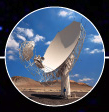Solar radio emissions come from accelerated electrons or from the thermal emission of the hot corona. They give a unique diagnostic of accelerated particles in the corona, and can help alone, or most often with observations at other wavelengths, to solve problems like particles acceleration in flares and propagation of particles toward the interplanetary medium. Large magnetic disturbances (i.e. coronal mass ejections) may be observed by the radio emission of the particles which are accelerated when the magnetic field of the moving disturbance reconnects with the coronal magnetic field. Acceleration of electrons may also occur in shocks, and the radio emission allows us to observe shocks propagation in the corona.
The thermal emission of the corona gives good models of the corona density and temperature, and shows a lot of structures which are related to the mostly unknown coronal magnetic field. These structures are probably connected to the solar wind.
Radio observations of the sun require specific capabilities for the radio telescopes, like a very good snapshot imaging, and accurate brightness measurements on a rather large object. Both need a dense uv coverage.
We will present some results and difficulties of Lofar, and what we can hope from other present (MWA) or future instruments.
Par auteur > Kerdraon AlainSun and Space weather
1 : Laboratoire d'études spatiales et d'instrumentation en astrophysique
(LESIA)
-
Site web Université Pierre et Marie Curie [UPMC] - Paris VI, Observatoire de Paris, INSU, CNRS : UMR8109, Université Paris VII - Paris Diderot, Université Pierre et Marie Curie (UPMC) - Paris VI
5, place Jules Janssen 92190 MEUDON -
France
|

 PDF version
PDF version
